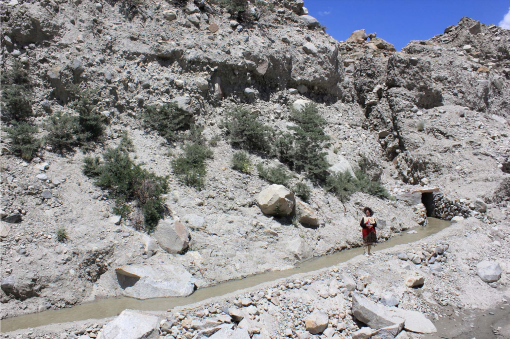
The cryosphere thinning results in the loss of rare species and their habitats, changes in infrastructure, food, and water: Dr Sitara Parveen
Herald Report
The thinning of the cryosphere is a major threat to the livelihoods of the mountain communities in north-western Himalaya, Trans-Himalaya, the Karakoram, and Hindu Kush mountain ranges. There is a need for adaptive strategies to cope with climate change effects on the cryosphere-fed irrigation system says a new research paper.
“Irrigated agriculture is fundamental for the livelihoods security of mountain farming communities in the north-western part of the Himalaya, Karakoram, Hindu Kush, and Trans-Himalayan region”, suggests the paper, produced by a group of researchers at Germany’s Heidelberg University.
The cryosphere — the portion of the Earth’s surface where water is in solid form for at least one month of the year—has been shrinking due to global warming.

Based on three case studies from Nanga Parbat, upper Hunza, and Ladakh region the paper, titled “Cryosphere-Fed Irrigation Networks in the Northwestern Himalaya: Precarious Livelihoods and Adaptation Strategies Under the Impact of Climate Change” has been authored by authors are Marcus Nüsser, Juliane Dame, Sitara Parveen, Benjamin Kraus, Ravi Baghel and Susanne Schmidt from South Asia Institute, University of Heidelberg, and Heidelberg Centre for Environment, Institute of Environmental Physics Heidelberg University, Germany and published in the latest issue of the Journal of Mountain Research and Development.

Dr Sitara Parveen, one of the co-authors of the paper, told The High Asia Herald that “the ice, snow, and glaciers in northwestern Himalaya, Karakoram, and the Hindu Kush have been decreasing, thus affecting the ecosystems in the cryosphere.”
She obtained her PhD degree from Heidelberg University and teaches as Assistant Professor of Geography at the Fatima Jinnah Degree College for Women, Gilgit.
Dr Parveen studied at Bonn University in physical geography with the main focus on climatology for two years and moved to Heidelberg University to adopt the interdisciplinary approach of Human Geography by analysing the climate and socio-economic changes taking place in the mountain region of Gilgit-Baltistan.
In her thesis, “Socio-hydrological Nexus of Mountain Agriculture in Gilgit-Baltistan”, she analyzed the impact of climate change on the farming communities in 10 villages of Gilgit-Baltistan such as Hushe, Khaplu, Shigir Khurd, Satpara, Eidgah, Gudai in Baltistan Division, and Danyore in Gigit District, Hoper in Nagar District as well as Aliabad and Shimshal valley in Hunza District.
She also selected four villages from Gojal (upper Hunza) to identify the environmental and socio-economic factors influencing the local farming communities and their adaptation strategies.
Dr Parveen explored the dynamics of Batura, Passu, Ghulkin and Gulmit glaciers and their consequences for the irrigation system and the local communities’ livelihoods.
The results indicate that the glaciers in the study areas have not only decreased but also interrupted by fluctuations over the last five decades.
The study also suggests that the adaptation strategies are shaped by the dynamics of the cryosphere, the glacio-fluvial hazards as well as by the available workforce. The sophisticated human-environmental relationship is also challenged by the off-farm activities and migration of young people from the region.
According to Dr Parveen, the cryosphere thinning results in the loss of rare species and their habitats, changes in infrastructure, food, and water.
The runoff from glaciers is highly crucial for crop production in these mountain valleys. The mountain farming communities have developed a sophisticated irrigation system to cope with frequent water scarcity caused by glacier dynamics such as retreat, thinning as well as changes in snow-cover or ice fields.
The study has been done using multiple research methodologies such GIS and remote sensing techniques, field visits and mapping of irrigation channels and ice reservoirs as well as interviews of community members and experts.

The comparative analysis indicates diverse responses and strategies to water scarcity depending on the local conditions ranging from construction of new irrigation channels, installation of pipes and building of artificial ice reservoirs.
All these strategies require constant efforts from the water users such as labour and cash input, rotation and water management system and external development interventions, the paper says.
“Despite these strategies abandonments of irrigated fields can be witnessed in the study villages mainly caused by increased off-farm opportunities and outmigration to urban centres, she said.
However, the adaptive strategies often fail in the face of cryosphere dynamics such as glacio-fluvial hazards including glacier-lake outburst floods (GLOFs), flash floods, landslides, and rockfall.
All these case studies show that water users face substantial labour shortage which subsequently affects the capacity of the communities to establish successful adaptation strategies.
The paper suggests that the glaciohydrological and socioeconomic factors need to be highlighted and explored in detail for a better understanding of site-specific climate change adaptation strategies and development options. For reading the complete paper, click here.

